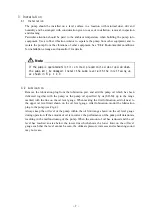
- 7 -
3. Installation
3.1 Installation
The pump should be installed on a level surface in a location with minimal dust, dirt and
humidity and be arranged with consideration given to ease of installation, removal, inspection
and cleaning.
Particular attention should be paid to the ambient temperature when building the pump into
equipment. Use a rubber vibration isolator to separate the pump from other equipment and to
isolate the pump from the vibrations of other equipment. See “
0.4.2 Environmental conditions
for installation, storage and operation
” for details.
If the pump is operated whilst it is tilted, placed on its side or upside-down,
the pump will be damaged. Install the pump level with the inlet facing up
as shown in Fig. 1,2,3.
3.2 Lubrication
Remove the lubrication plug from the lubrication port, and add the pump oil which has been
delivered together with the pump or the pump oil specified by us (SO-M) up to the range
marked with the line on the oil level gauge. When making the first lubrication, add oil near to
the upper oil level limit shown on the oil level gauge. After lubrication, mount the lubrication
plug to the pump (see Fig. 4).
Always keep the oil level of the pump within the oil limit range shown on the oil level gauge
during operation. If the amount of oil is incorrect, the performance of the pump will deteriorate
resulting in the malfunctioning of the pump. When the amount of oil has reduced and the oil
level has reached an area below the lower line which shows the lower limit on the oil level
gauge such that the level cannot be seen, the ultimate pressure increases and exhausting sound
may not cease.
Note
















































